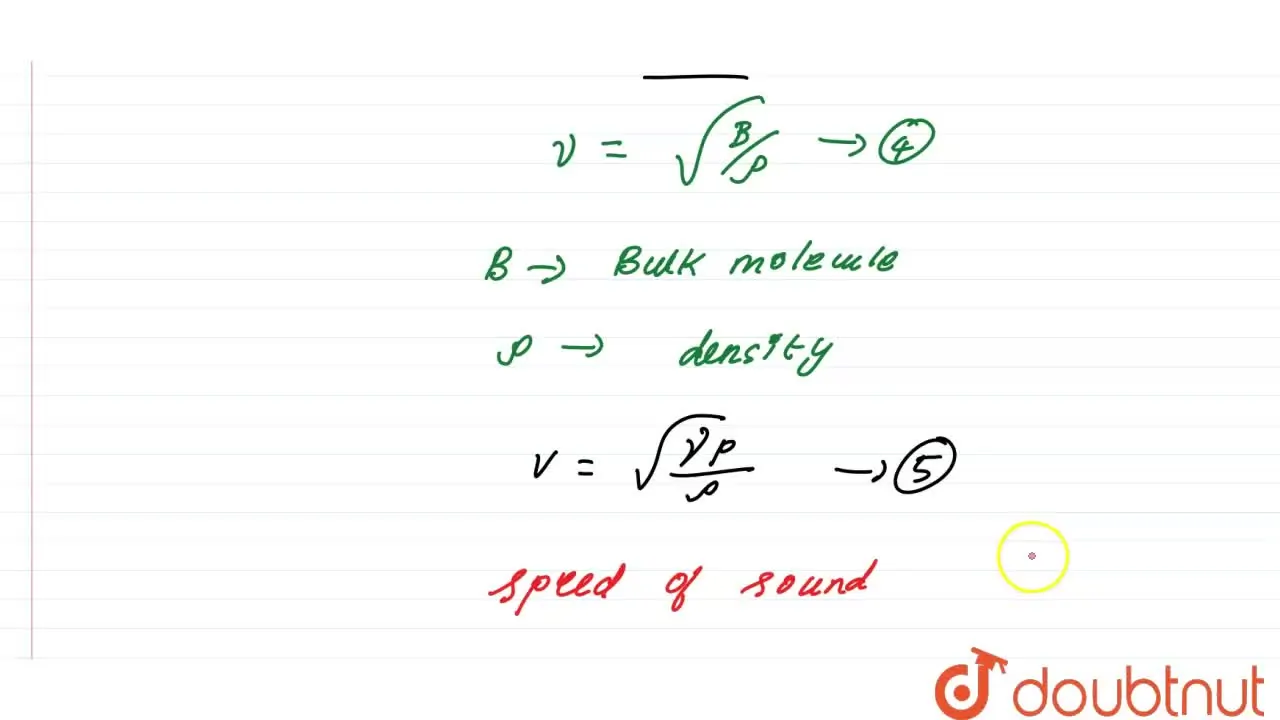Explain Laplace's correction.Solution in Tamil
Laplace.s correction: In 1816, Laplace satisfactorily corrected this discrepancy by assuming that when the sound propagates through a medium, the particles oscillate very rapidly such that the compression and rarefaction occur very fast. Hence the exchange of heat produced due to compression and cooling effect due to rarefaction do not take place, because, air (medium) is a bad conductor of heat. Since, temperature is no longer considered as a constant here, sound propagation is an adiabatic process. By adiabatic considerations, the gas obeys Poisson.s law (not Boyle.s law as Newton assumed), which is
PVγ = Constant ....(1)
where γ=CpCv which is the ratio between specific heat at constant pressure and specific heat at constant volume. Differentiating equation (1) on both the sides, we get
VγdP+P(γVγ−1dV)=0
or γP=−VdpdV=BA
where, BA is the adiabatic bulk modulus of air. Now, substituting equation (2) in equation V=√Bρ the speed of sound in air is
vA=√BAρ=√γPρ=√γvT
Since air contains mainly, nitrogen, oxygen, hydrogen etc, (diatomic gas), we take γ = 1.47. Hence, speed of sound in air is vA=(√1.4)(280ms−1)=331.30ms−1, which is very much closer to experimental data.
Related Playlists
- BOOK - FULL MARKSCHAPTER - SAMPLE PAPER -10 (SOLVED)EXERCISE - PART-IV12videos
SAMPLE PAPER -10 (SOLVED)
- BOOK - FULL MARKSCHAPTER - SAMPLE PAPER -10 (SOLVED)EXERCISE - PART-II9videos
SAMPLE PAPER -10 (SOLVED)
- BOOK - FULL MARKSCHAPTER - SAMPLE PAPER -1EXERCISE - PART-IV10videos
SAMPLE PAPER -1
- BOOK - FULL MARKSCHAPTER - SAMPLE PAPER -3 (SOLVED)EXERCISE - PART-IV10videos
SAMPLE PAPER -3 (SOLVED)
Similar Questions
What are the applications of dimensional analysis? Verify s=ut+12at2 by dimensional analysis
07:19View SolutionA girl is swinging on a swing in the sitting position. How will the period of swing be affected if she stands up?
06:47View SolutionDescribe the construction and working of venturimeter and obtain an equation for the volume of liquid flowing per second though a wider entry of the tube
01:11View SolutionDiscuss the effect of rolling on inclined plane and derive the expression for the acceleration.
03:37View SolutionLAPLACE'S CORRECTION
11:47View SolutionState Newton's formuls for velocity of sound in air. Point out the error and hence discuss Laplace's correction.
03:55View SolutionLaplace's correction in the formula for the speed of sound given by Newton was needed because sound waves
06:55View SolutionDerive Laplace's law for a spherical membrane.
08:40View SolutionDiscuss Newton’s formula for velocity of sound in air medium and apply Laplace’s correction.
05:14View SolutionDescribe Newton's formula for velocity of sound waves in air.
02:27View SolutionDerive an expression for escape speed.
01:46View SolutionDerive Laplace's law for spherical membrane.
04:31View SolutionExplain Laplace's correction to the Newton's formula for velocity of sound in air.
05:48View SolutionChoose the correct option? The Laplace's correction in the expression for velocity of sound given by Newton is needed because sound waves
05:24View SolutionChoose the correct option? The......is developed during compression according to Laplace's formula for speed of sound.
02:25View Solution


